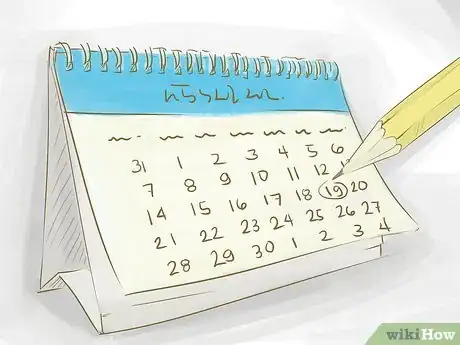This article was written by Jennifer Mueller, JD. Jennifer Mueller is an in-house legal expert at wikiHow. Jennifer reviews, fact-checks, and evaluates wikiHow's legal content to ensure thoroughness and accuracy. She received her JD from Indiana University Maurer School of Law in 2006.
This article has been viewed 11,771 times.
The British legal system provides for private citizens to challenge the lawfulness of actions by public authorities such as the local government by seeking judicial review of those actions. The process described here applies to the UK, although other countries with British-style legal systems may also have similar judicial review procedures available. While the process by which you seek judicial review is fairly straightforward, the arguments and proof required may mean you should seek legal counsel to assist you in preparing the necessary documents.[1]
Steps
Completing the Pre-Action Protocol
-
1Make note of judicial review application deadlines. Pre-action protocol is recommended by the courts to avoid unnecessary litigation, but following this protocol does not toll or extend any applicable deadlines for lodging an application seeking judicial review.[2]
- Generally, you should lodge your application for judicial review as soon as possible, but no later than three months after the issue arose.
- If you intend to lodge an application for judicial review with the Planning Court, you have only six weeks from the date the issue arose to begin the process.
- In some situations, your deadline may be as short as 14 days from the date the issue arose. If you think your claim may fit into one of these narrow scenarios, you should consider consulting legal counsel before you proceed.
-
2Draft a letter to the defendant. Before you file a claim and apply for judicial review, pre-action protocol dictates you should send a letter to the party you intend to sue to identify the issues you have and find out whether a compromise can be reached that could avoid court action.
- In your letter, include the date and details of the decision or action you're challenging along with a summary of the facts upon which your claim is based.
- If you need additional information regarding the decision or action, state exactly what information you want and why you believe that information is relevant to your claim.
- State what you want to happen to resolve the situation and set a deadline 14 days from receipt for the party to respond to your letter.
Advertisement -
3Seek legal advice. Although the courts recommend following the pre-action protocol, it may not necessarily be the best or most expedient thing to do in all circumstances. If you have any questions regarding whether sending a letter is worth it, you may want to talk to a legal advocate.
- The courts don't recommend lodging your application for judicial review until after the deadline for a response to your letter. However, if the deadline is fast approaching, legal counsel can advise you on how to handle the situation.
- In some situations, sending a letter is impractical. Legal counsel will be able to outline the reasons you should or shouldn't comply with the court's pre-action protocol, and advise you on what steps to take.
- For example, if application is urgent due to the details of your complaint or the nature of the decision or government action, sending a letter may not be appropriate.
- A letter also isn't appropriate if the person you plan to name as a defendant doesn't actually have the legal power to change the decision or reverse the action you're challenging.
-
4Send your letter. Once you've finalized your letter, print and sign it and then make a copy of the signed letter for your records. Mail your letter using a method that allows you to track delivery so you know when it is received by the other party.
- You also can fax your letter to the defendant, which provides instant delivery as well as confirmation of receipt.
- Particularly if the deadline to lodge your application for judicial review is looming, you may want to include with your letter a draft of the claim form you intend to file if the matter isn't resolved to your satisfaction.
-
5Wait for a response. Pre-action protocol dictates that the other party should respond to your letter within 14 days of receipt. The courts may impose sanctions on the other party if they don't respond within that period without good reason.
- If the defendant is amenable to reversing or quashing the decision or action you've challenged, there will be no reason to seek further judicial review.
- However, if the defendant refuses to work with you to resolve the dispute or is unwilling to provide you the information you need, you'll have to file a claim seeking judicial review.
Submitting Your Application
-
1Draft your claim form. An application for judicial review is made by completing claim form N461. If you're seeking judicial review from the Planning Court, you must complete claim form N461PC.[3]
- The claim form requires information about you and the defendant, as well as a list of any interested parties. For the purposes of your claim, "interested parties" include anyone who would be directly effected by the court's decision in your case.
- You also must explain the factual and legal basis for your claim and any actions you've already taken to attempt to resolve the claim.
- You may want to consider hiring legal counsel to assist you in drafting your claim form. While the courts don't have the power to grant funding or legal aid to provide you with free legal assistance, you may be able to get some help with a community legal services office.
- Your community legal services office also can provide you with the names of solicitors in your area who handle claims such as yours.
-
2Gather your supporting documentation. Your claim form must be accompanied by a detailed statement of the legal basis of your claim, a statement of the facts upon which your claim relies, and any written evidence that supports your claim.[4]
- Along with your claim form, you must include copies of any documents you intend to use as evidence in support of your claim or arguments, as well as any laws, judicial decisions, or regulations that support your argument that the action or decision of public authorities was unlawful.
- You also should include any other documents or reference material you'd like to provide the court for "advance reading." You must provide the entire document, but if it isn't relevant to your claim in its entirety, you can highlight or mark the portions that apply to your argument.
- If there are documents or references you need and intend to use as support for your argument, but you can't acquire copies, you must provide the court with a list of those items and the reason you weren't able to get copies to file with your claim.
- Depending on the subject matter of your claim, these documents may be voluminous. Particularly for complex claims, hiring legal counsel to draft your arguments and help pull together these documents may be inescapable.
-
3Finalize your application package. Gather together all documents and forms you completed and make copies for each defendant or interested party you intend to serve, as well as one copy for your records.
- All of the documents you file in support of your claim must be paginated and indexed for ease of reference. The entire bundle should use consecutive page numbers, even if each document has its own internal page numbers.
- You also must create an index page that contains a list of each document included, its title, a brief description of the document, and the bundle page number at which it begins.
- If your claim is of a criminal nature, you must submit two copies of the entire bundle of documents to the court.
- You also must provide a separate paginated, indexed bundle of relevant laws, court decisions, or statutory provisions that apply to your claim.
- This separate bundle is required if you've hired legal counsel. If you're working on your own without the benefit of counsel, you still should attempt to meet this requirement as best you can.
-
4Lodge your application. You must commence your action in the Administrative Courts. In Birmingham, Cardiff, Leeds, or Manchester you can lodge your application with the District Registry of the High Court as well as the Royal Courts of Justice in London. Claims typically are handled by the applicable regional courts.
- Generally, your claim will be dealt with by the court in the region with which you have the closest connection, although there are some exceptions.
- A claim may be handled in a court in another region if the parties agree or if the other region's court would be more convenient.
- In some situations a claim may be moved to another region if the court where you lodged your claim has a significant volume of claims to address or if the other court is handling other claims that raise similar issues.
- When you lodge your claim, you must pay a fee of £140. You can pay using cash, cheque, postal order, credit or debit card. Some forms of payment are only accepted if you make them in person.
- You may be entitled to remission of any fees due if you are receiving certain forms of public benefits. Ask for a Form EX160 Application for Fee Remission at the Administrative Court Office.
- After payment of your fees, your documents will be sealed and the court will issue your claim.
-
5Serve the defendant and interested parties. You must serve sealed copy claim forms and supporting documents on the defendant as well as any other person likely to be directly affected by your judicial review.
- Service must be completed within seven days of the date shown on the court seal. You must arrange for service yourself; the Administrative Court Office won't do it for you. Service typically is accomplished using first class post.
- You must file a Certificate of Service within seven days of the date your bundle of documents is served on the defendant and other interested parties.
- Within 21 days of the date of service, the defendant or any interested parties who want to take part in the judicial review must file a Form N462 Acknowledgement of Service. Typically you should include a blank copy of this form with the bundle of documents with which you have them served.
- The acknowledgement of service will set forth a summary of the grounds upon which the person contests your claim, as well as the names and addresses of anyone else that person considers an interested party who wasn't named by you in your claim.
-
6Wait for permission to proceed. Your application for permission to seek judicial review will initially be considered by a single judge. That judge will evaluate your claim and the acknowledgement of service forms filed by the other parties and serve you with a form providing his or her decision and the reasons for it.
- The decision will be communicated to you on a Form JRJ. This form will let you know whether your case will be forwarded for judicial review or whether permission to seek judicial review is denied.
- You can lodge a request for reconsideration if the judge denies you permission. A fee of £350 must accompany your request.
- If permission is granted, you must pay an additional fee of £700 within seven days if you wish to proceed, unless you've previously qualified for a fee remission.
- If you were previously operating under a remission of fees, you must file an additional application for fee remission to cover any fees required after permission to proceed is either granted or denied.
Proceeding to Your Hearing
-
1Receive your case management directions. After you are granted permission to proceed with judicial review, you may receive a packet of papers that direct the progression of the case from that point, including instructions regarding venue, service of the claim form, and any evidence.
- The defendant or any interested parties have 35 days from the date of service of the order granting permission to lodge with the court and serve on you and all other parties any written evidence upon which they intend to rely.
- This evidence packet also must include any legal arguments they intend to use either to contest or support your claim.
- Keep in mind that the court may shorten or lengthen the amount of time all parties have to submit their evidence bundles, depending on court schedules, the number of parties involved, or the complexity of your claim.
-
2List your case for hearing. Once the time for the lodging of evidence is over, the court will send you notice that your case is ready to be listed for hearing. If your case qualified for an expedited hearing, it will be given precedent over other cases waiting to be set.
- The procedure for listing a case for hearing is the same regardless of whether you are represented by legal counsel.
- All parties will be provided a range of dates, and will have 48 hours to choose one of them.
- If the parties collectively fail to contact the Administrative Courts Office with a chosen date, the Office will assign one and notify the parties of that date without further opportunity to decide, so it's important to get together with the other parties and choose the date you prefer as soon as possible after you are provided with the range.
- If you are unable to appear in court for your hearing after a date is fixed, you must file an application to have the date changed including a legitimate reason for doing so, and will have to pay an adjournment fee of £155, or £50 if all parties agree.
-
3Lodge a skeleton argument. While a skeleton argument is not strictly required for any litigant, you should consider drafting and submitting one if you believe it would aid the court. If you decide to draft one, it must be filed with the court and served on all parties at least 21 working days before the date of your hearing. Your skeleton argument must include:
- A list of all parties, witnesses, and other people mentioned or referenced in your claim;
- A chronology of events cross-referenced with documents in your bundle;
- A list of the legal issues you intend to address, and your stance on those issues;
- An index of all legal authorities you intend to reference, with copies of those documents; and
- Any other documents or articles you wish to provide to the court for advance reading or background information.
-
4Lodge your trial bundle. Your trial bundle is a paginated and indexed set of documents required by any party for evidentiary or reference purposes during the judicial review hearing. Although some documents in your trial bundle may duplicate documents included in your skeleton argument, your trial bundle must be lodged regardless of whether you elect to lodge a skeleton argument.
- The trial bundle also must be filed with the court and served on all parties at least 21 working days before the date of your hearing.
- If you settle your claim with the defendant at any time before your hearing is scheduled, you may file a document with the court detailing the settlement and signed by you, the defendant, and any interested parties.
- You must lodge two copies of the settlement document and pay a fee of £50 to have a consent order issued adjourning the hearing and closing your claim.





































































